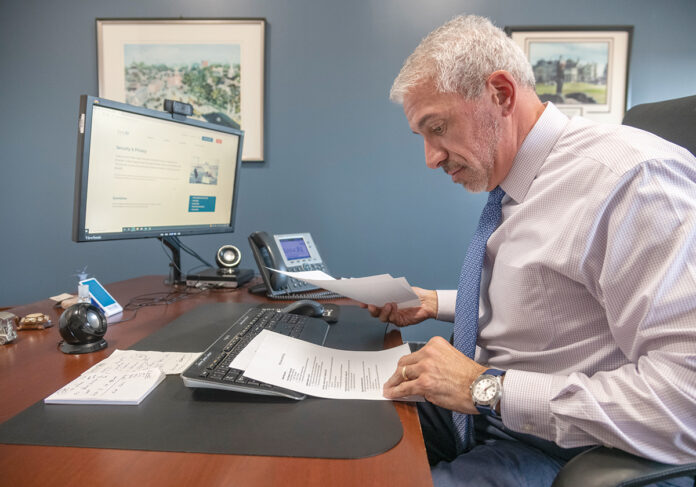The nightmare begins with a text message that appears to come from the bank, alerting the customer to a suspicious, unauthorized transaction.
Thousands of dollars are gone from your checking account, the message says. The money was spent on merchandise at a shopping center halfway across the country.
But, what a relief, there’s a way to reclaim those funds and quickly resolve this awful mess, according to the agent on the other end of the phone. Just click a button in the mobile banking app to approve a reverse transfer of those funds. And at that moment, the grifter has successfully hooked his mark.
“These people are very sophisticated,” said Steven M. Parente,
executive vice president and director of retail banking for Bank Rhode Island. “It’s an awful thing that occurs. Unfortunately, there’s just so much more opportunity for fraudsters in this society.”
Throughout the past year, there’s been a rise in reports of scammers targeting banking customers throughout the nation, including Rhode Island, involving a con that tricks victims into authorizing an account transfer using the popular Zelle app or some other mobile payment platform connected to the bank, according to financial experts and consumer reports.
Recently, dozens of such cases have made headlines nationwide, in states including Georgia, where an Atlanta teacher said in November that she was taken for $3,500 in savings from her Wells Fargo bank account after a scammer tricked her into approving a bank transfer through Zelle, which partners with more than 1,000 participant banks.
Some of the largest banks in the Rhode Island market – including Bank of America Corp. and Citizens Bank – offer Zelle to their customers.
‘Younger people who do everything mobile, they don’t think twice about it.’
STEVEN M. PARENTE, Bank Rhode Island executive vice president and retail banking director
A study by the U.S. Public Interest Research Group found that of the 9,277 complaints filed since 2017 with the Consumer Financial Protection Bureau regarding these peer-to-peer payment services, approximately 5,200 were filed in the one year alone preceding last April, the majority of those complaints involving fraud, scams or unauthorized transactions. In April alone, there were 970 complaints filed about peer-to-peer payment apps, which is almost double the previous monthly record set in July 2020.
Parente said some BankRI customers have been among those targeted. Although he declined to say how many customers were involved, Parente said scammers attempted to steal “thousands of dollars” in many cases. During some weeks this year, there have been as many as eight attempts to defraud BankRI customers, Parente said.
While many fraudsters have been known to target vulnerable senior citizens, Parente said this scheme takes advantage of the younger generations’ fluency and affinity for convenient smartphone technology.
“We’ve had older people get those messages, and they almost seem more leery of these things and will call us to verify,” Parente said. “Whereas with younger people who do everything mobile, they don’t think twice about it.”
In addition, Parente said, the scammers use a technique called “spoofing,” which enables them to mirror the caller ID of the victim’s bank company, making the fraudulent text or phone call seem legitimate.
“It’s unnerving,” Parente said. “There has been no way to stop this. That was our biggest frustration.”
Paul Benda, senior vice president of operational risk and cybersecurity at the American Bankers Association, said he’s hopeful that the Federal Communications Commission’s new STIR/SHAKEN program, requiring phone and voice service providers to implement call authentication protocols, will eventually eliminate “spoofing” calls.
“That would go a long way,” Benda said.
The key for banks when incorporating peer-to-peer payment software into their online banking platforms is to balance convenience demanded by customers and the security needed to protect them, Benda said. In the case of peer-to-peer payment apps, it’s ultimately up to the user to authorize a payment. So the best way to protect banking customers from such an unwitting bank transfer is through education, Benda said.
“The hard part is trying to educate consumers,” Benda said. “These scammers are very good at what they do. Sometimes they buy specific personal info on the dark web. They can sound very convincing.”
Bank of America said it sends fraud alerts to customers when they’re making peer-to-peer transactions to new recipients.
“They should only send to people they trust, and never transfer money as a result of an unexpected call or text,” the bank said in an email.
Benda said that to combat scammers, the bankers association is spreading awareness through its “Banks Never Ask That” campaign, which offers tips on how to deal with any phone call, text message or email from someone claiming to represent the bank. Crucially, Benda said, banking customers should “never act in haste.”
“Hang up and call the telephone number you know as your bank,” Benda said. “Are they going to ask you to send money via Zelle to another account? No.”
Parente said BankRI also uses fraud detection software that alerts the bank to suspicious activity, due to the size and frequency of a client’s transactions compared with their prior transaction history and whether the recipient of a transfer is new for the customer.
“We immediately block it. That has probably stopped 95% of attempts,” Parente said. “There’s a whole team that goes through a secondary verification process. It defeats the purpose of convenience, but we slow it down to do a check and verification, to make sure with the customer.”
Marc Larocque is a PBN staff writer. Contact him at Larocque@PBN.com.










